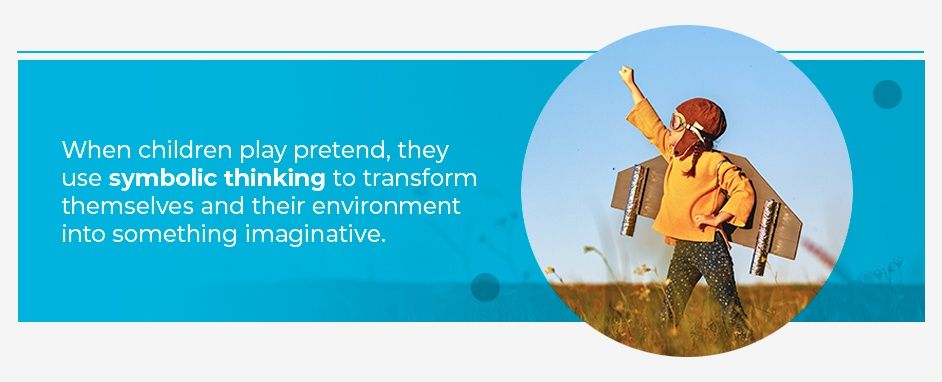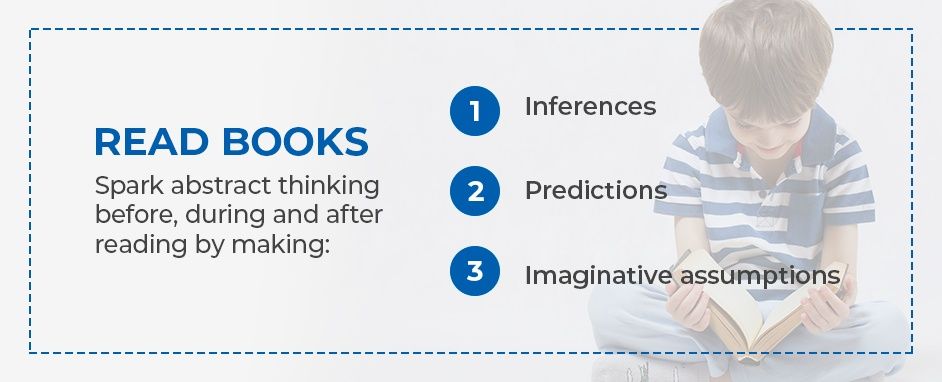How to Improve Abstract Thinking in Young Children

Can you imagine a dystopian world of only concrete thoughts?
It would be a world of black-and-white thinkers, where we wouldn’t have access to modern technology like airplanes, lightbulbs or cellphones. Forget modern technology — we would not even have access to our favorite movies or books!
Abstract thinking allows us, as humans, to transform simple thoughts into new, imaginative adaptations. We learn how to create abstract thoughts by breaking concrete-thinking boundaries through experience.
Here, we will break down what abstract learning is and give you the tools to spark abstract thoughts in children’s daily lives.
Read the full article or jump to a specific section:
- What Does Abstract Thinking Mean?
- Is Abstract Thinking Automatic or Learned?
- 4 Activities to Help Children Develop Abstract Thinking Skills
- Spark the Thrill of Abstract Learning at the Playground
What Is Abstract Thinking?
Abstract thinking is the ability to understand concepts that are not directly tied to physical objects or experiences. As children develop, they use abstract thinking to:
- Classify objects and experiences.
- Deal with situations they have not experienced before.
- Draw conclusions based on existing information.
- Plan a sequence of events.
- Identify solutions to problems.
Take the Statue of Liberty, for example. Children may recognize that the Statue of Liberty is important and possibly be able to recite a fact or two — which is concrete thinking — about when or how it was constructed. Kids who practice abstract thinking understand that the Statue of Liberty is a globally recognized symbol of freedom, justice and liberty.
People do not wake up one day magically able to make these deeper connections to concrete thoughts. As we face new experiences, we learn these skills by asking ourselves, “Why does this happen?”
Is Abstract Thinking Automatic or Learned?
Abstract thinking occurs automatically, but can be advanced and strengthened through continual experiences. Educational experiences happen naturally, like when making a new friend or learning a skill, but other situational experiences are equally important.
The more experiences kids have, the more abstract concepts they can think throughout child development.
For example, kids absorb their culture’s written and spoken symbols from birth, like letters and numbers. In preschool, teachers teach kids that the number six stands for a group of six things. Next year in kindergarten, they learn that numbers have relationships, where you can subtract two things to make a smaller group of four.
You can reinforce and strengthen abstract thinking outside of their academic learning environment by letting kids apply their knowledge to other activities. A normal playground slide or climber could be imagined as a large mountain — can they make it to the top or reach the bottom to win a prize? These activities could also be something as simple as cutting a slice of pie for themselves.
Why did they choose that size of a slice? Why did they feel hungry? Why did they pick pie over any other food choice? Asking these “why” questions spark a deeper level of thought that is critical to abstract learning.
5 Activities to Help Children Develop Abstract Thinking Skills
No matter your role in a child’s life, you can help guide their experiences to develop deeper abstract thoughts. Some ways to develop children’s abstract thinking include:
- Encouraging dramatic and imaginative play
- Writing and sharing stories
- Reading books & thinking about the meaning
- Looking for patterns and relationships
- Performing science experiments & thinking about the results of experiments
The most important thing to consider when doing these activities is letting your child naturally discover their abstract thinking competence. Do this by revisiting those “why” questions, and comfortably push their thought process toward the answer. Here are the above strategies in more detail:
1. Encourage Dramatic Play
A kid practicing concrete thinking sees a banana as a tasty fruit. One who practices abstract thinking views a banana as a fruit, too, but also as a telephone to call friends with, a smiley face to alter their facial expression with or whatever else they can imagine.
Stimulate kids’ imaginations and encourage them to engage in abstract concept play. Focus on familiar stories, like calling their favorite TV show character on their banana phone. Why are they calling them? Did something bad happen, or are they congratulating them on a huge achievement?
When children play pretend, they use symbolic thinking to transform themselves and their environment into something imaginative. This practice helps them make sense of something that has not actually happened. Themed playground equipment can serve a similar purpose by encouraging children to expand their thought processes relating to the world around them.
2. Write Stories
Similar to using the theory of dramatic play, you can activate a kid’s abstract mind by encouraging them to imagine and write their own stories.
By writing, they learn that letters and numbers are symbols they can use to represent their thoughts. Breaking this mental boundary between reading others’ already-written ideas and expressing their own is groundbreaking to their abstract thinking ability.
Even if a child cannot write yet, they can use their own symbols to write down their ideas. These may look like carefully scribed scribbles, but your child is still practicing the same abstract thinking process.
3. Read Books
For their next read, allow your kid or student to pick out a book that seems interesting to them. Spark abstract thinking before, during and after reading by making:
- Inferences: Before reading, ask them what made them pick that book. Was it an interesting size? Did the cover draw their attention? Using the information on the front and back cover, entice them to draw inferences on what they think the book is about.
- Predictions: While reading, take a few pauses and allow them to make predictions on what will happen next. Will the main character find what they are looking for? What problems will they face along the way?
- Imaginative assumptions: After reading, ask them what they think happened in the prequel to get the characters to the plot at the beginning of the current book. Or, ask what will happen in the sequel — even if neither exists — given the information they already have.
By using these abstract thoughts, they’re developing a cause-and-effect understanding of a sequence of events and identifying solutions to a character’s imaginative problems. This skill will help them when tackling real-world experiences.
4. Prioritize Pattern Recognition
Abstract thinking is about seeing the bigger picture, so looking at past experiences and applying them to the current situation is a crucial skill to develop. You can encourage a child to ask questions to themselves such as:
- Have I seen this anywhere before?
- How is this similar (or different) from a past experience?
- What happens next based on my previous experience?
You can also find many engaging, visual games online that can help kids develop pattern recognition skills and improve their abstract thinking skills.
5. Perform Science Experiments
Science experiments are great ways to keep kids’ minds engaged in abstract thinking while also enjoying different science, technology, engineering and math (STEM) concepts. The experiments do not have to be groundbreaking or above your budget. These activities only have to get children asking, “Why does this happen?”
Some experiments you can do with kids to promote abstract thinking include:
- Egg drop: For this experiment, all you need is a carton of eggs and a place — or places — that can get messy. Give your kid an egg and ask them what they think will happen if they drop it on different surfaces. This gives them a chance to develop and practice simple cause-and-effect language and provides them a visual to compare it to. As a challenge, add a boiled egg or two to the mix.
- Color exploration: This is another activity young kids can try. Have them mix primary colors together to make the colors of the rainbow. For kids who have the color combination memorized, ask them what happens if they blend secondary colors. Why do only some combinations result in brown, and others do not?
- Water mass theory: Grab three glass cups — two of the same size, and one thinner and taller. Place these cups together on the table and fill the same-sized cups with the same amount of colorful liquid. Ask your kid which glass between the two has more water. They will likely state the correct answer that they are the same. Challenge this idea by pouring the liquid from one cup into the thinner glass. Visually, it will look like this cup holds more. Ask them the same question and see if their response changes.
You can promote similar cause-and-effect thinking in a kid’s daily life, too. For example, the next time you are outside, identify your environment’s aspects and ask thought-provoking questions. If you see a bird, ask them why birds can fly and people cannot.
Spark the Thrill of Abstract Learning at the Playground
Kids learn best when they engage in safe, hands-on fun. Our experts at Miracle® Recreation understand the importance of creating an inclusive playground where kids can learn child development skills, like abstract thinking.
Contact a Miracle Recreation Customer Service representative today for more information on how you can bring a specially designed, thrilling playground to the kids in your town!


